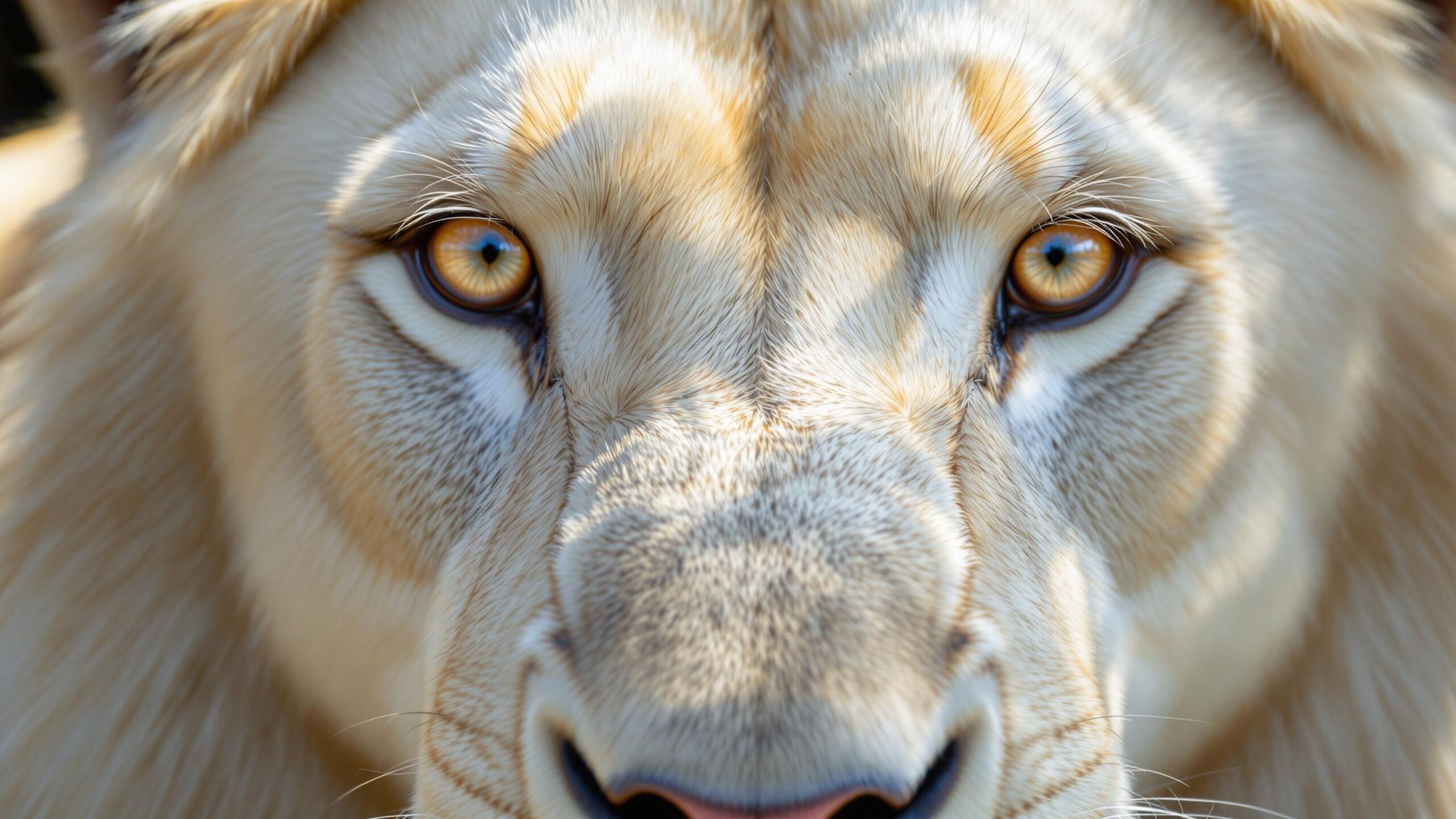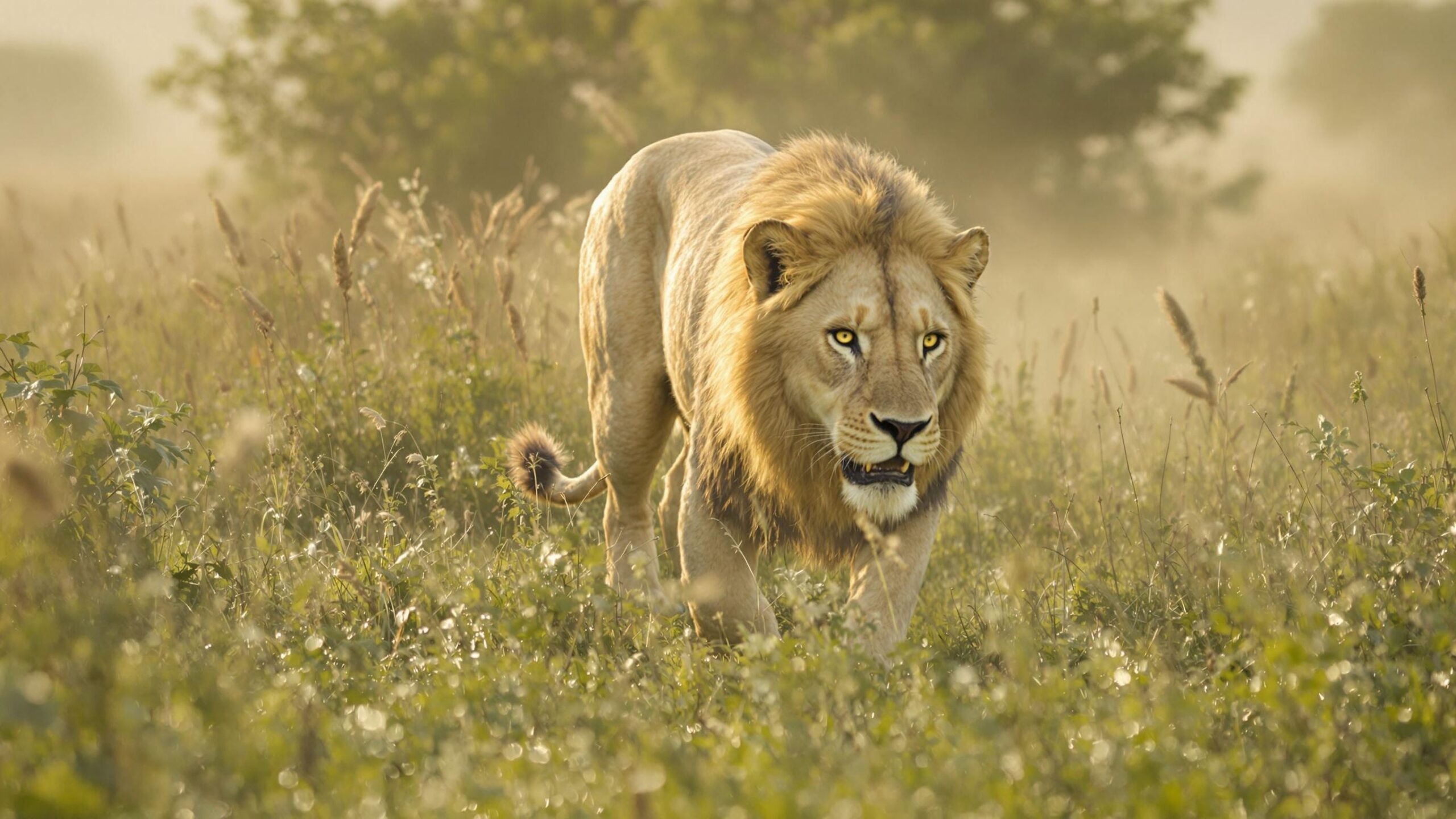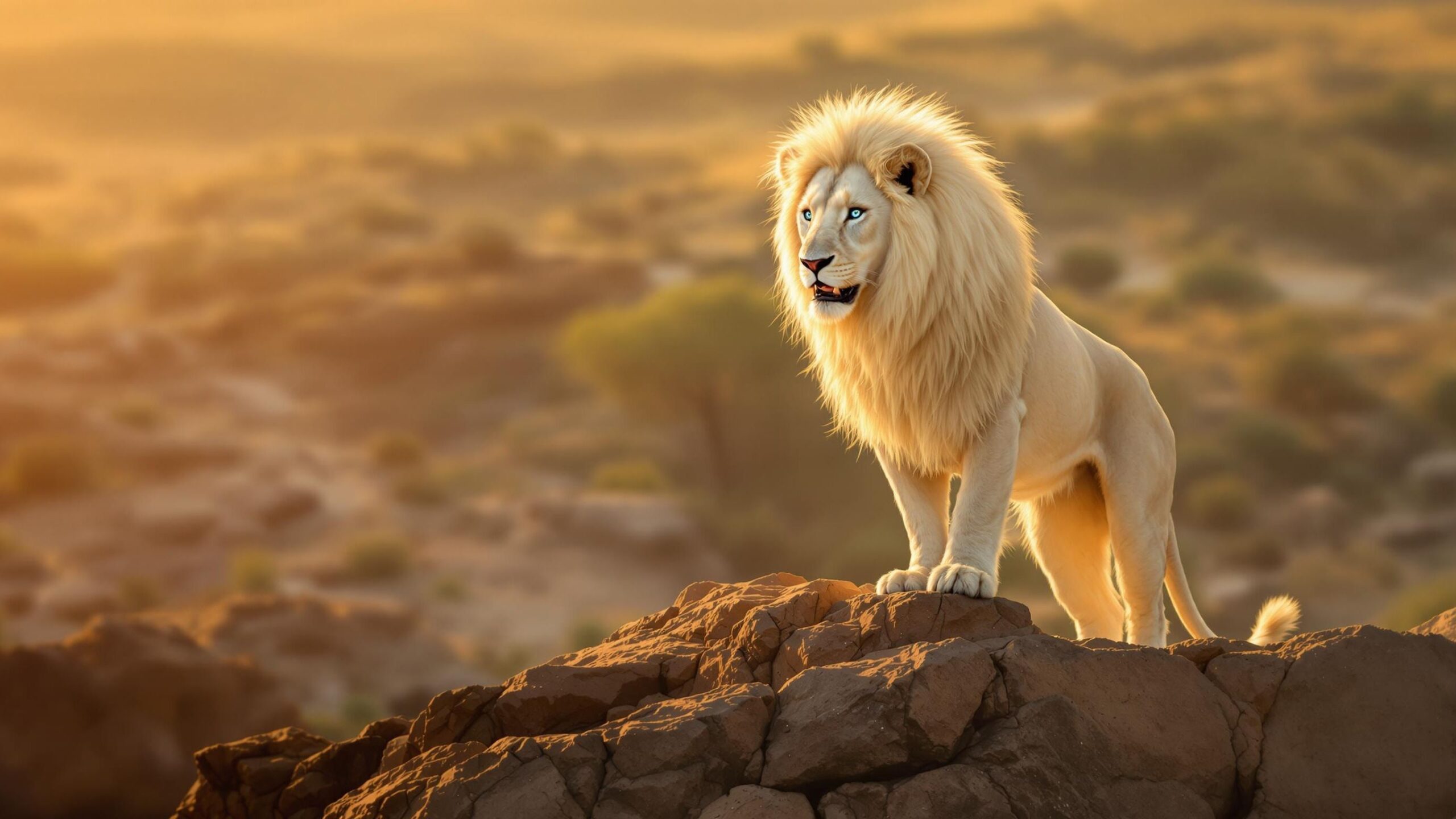The White Lion: Nature’s Living Legend of Light
Among the most mysterious and visually captivating animals on Earth, the White Lion (Panthera leo krugeri) occupies a unique place in the pantheon of big cats. With its ghostly pale coat, piercing amber or blue eyes, and ethereal presence, the white lion has captured the imagination of cultures, conservationists, and wildlife lovers across the world. But beyond its beauty lies a fascinating story of genetics, myth, adaptation, and survival.
Though often mistaken for an albino, the white lion is in fact a natural variant of the southern African lion, a majestic anomaly born from a rare recessive gene. While they were once believed to be the stuff of legend, white lions are real, and their legacy is as deep and rich as the golden savannas of Timbavati where they first emerged.
The Science Behind the Beauty: What Makes a White Lion White?
White lions owe their stunning pale coloration to a rare genetic trait called leucism, not albinism. Unlike albino animals, which completely lack pigment and usually have red or pink eyes, leucistic lions retain some pigmentation. This means their eyes, paw pads, and lips are normally colored—typically amber, blue-gray, or gold. The genetic basis of leucism in lions is due to a recessive allele in the chinchilla or color inhibitor gene. Both parents must carry this gene for the trait to express itself in offspring. Because of this, white lions can be born to tawny-colored parents if both carry the recessive gene.
Scientifically, white lions are classified under the same species and subspecies as other southern African lions: Panthera leo krugeri. They are not a separate species or subspecies but are instead considered a rare color morph of the Kruger lion, named after the Kruger National Park in South Africa. Their pale coats may range from platinum blonde to light gold, with some appearing almost snow white in bright sunlight. This coloration may appear impractical in the wild—especially for stealthy hunting—but white lions have been observed successfully surviving and hunting in natural settings, especially within their native range in southern Africa.
Origins and Natural Habitat: From Timbavati to the World
The Timbavati region of South Africa is ground zero for the white lion legend. Nestled next to the iconic Kruger National Park, Timbavati is not only known for its biodiversity but also for its spiritual and cultural heritage. Local Shangaan tribes consider the white lion to be sacred—a gift from the divine and a symbol of balance and peace. The first recorded sighting of a white lion in the wild was in 1938, although local oral traditions describe white lions dating back centuries. Since the 1970s, several white lion cubs have been born in and around Timbavati, sparking intense interest from scientists, media, and safari-goers.
White lions live in the same habitats as other African lions—grasslands, savannas, and sparse woodlands. These ecosystems offer both cover and prey, from zebra and wildebeest to buffalo and antelope. As apex predators, lions play a vital role in maintaining ecological balance by regulating herbivore populations and ensuring the health of the ecosystem. While white lions are native to South Africa, many of those alive today live in captive environments around the world, including zoos, sanctuaries, and specialized wildlife reserves. Their unique appearance has made them highly sought after in captive breeding programs and sometimes in unethical wildlife tourism, raising both conservation and ethical questions.
Behavior and Social Life: Pride and Power
Like their tawny counterparts, white lions are social animals, living in groups called prides. A typical pride includes related females, their cubs, and a small coalition of dominant males. Social bonds are strong, particularly among females who often hunt together, raise cubs cooperatively, and defend the pride’s territory as a team. White lions exhibit the same behavioral patterns as other lions. Males often patrol territory boundaries, using scent markings and roaring to ward off intruders. Females do the majority of the hunting and often synchronize births to help raise cubs in a cooperative nursery environment.
The pride structure allows lions to take down larger prey than solitary big cats. Their teamwork and coordination make them formidable hunters, even though lions are not the most efficient predators—success rates range from 20% to 30% in the wild. However, their opportunistic nature and adaptability compensate for failed hunts. Despite myths suggesting white lions might be weaker or more vulnerable than normal-colored lions, they are biologically and behaviorally just as capable. Their unique color may make them stand out more in certain terrains, but it does not appear to compromise their survival or social dynamics when they are raised in or reintroduced to natural settings.

The White Lion in Myth and Culture
Long before geneticists uncovered the mechanics of lion coloration, the white lion was revered as a mystical creature in South African lore. Among the Shangaan and other indigenous communities, the white lion symbolizes purity, leadership, and harmony between humans and nature. Stories often speak of a balance that will be restored to the Earth when white lions walk freely again.
The lion itself is one of the most iconic animals across human civilizations—from royal crests and religious texts to contemporary emblems of power and pride. The white lion, however, has an added layer of wonder. Its rarity and regal appearance have made it a favorite subject in modern fantasy literature, animations, and conservation iconography. In popular culture, the white lion is often presented as a symbol of hope and renewal, its color evoking peace, light, and spiritual awakening. These associations have helped fuel global interest in their protection, but they have also led to their exploitation in captive breeding and entertainment industries, where aesthetic appeal often overrides animal welfare.
Conservation and Controversy: Protecting the White Lion’s Legacy
Although white lions are not officially recognized as a separate subspecies, their rarity in the wild makes them a conservation concern. The Global White Lion Protection Trust (WLT), founded by Linda Tucker, has been at the forefront of efforts to preserve and rewild white lions in their native habitat. One of the main threats to white lions is their genetic dilution and mismanagement in captive breeding programs. In some facilities, inbreeding has been used to preserve the white gene, resulting in physical deformities, compromised immunity, and behavioral issues. Ethical concerns also arise from white lions being bred for commercial purposes, including the controversial “canned hunting” industry.
In contrast, responsible conservationists emphasize the importance of protecting the genetic integrity of white lions by allowing them to breed naturally within healthy prides and wild conditions. Rewilding programs in protected reserves in South Africa have demonstrated that white lions can thrive without human interference, hunt effectively, and contribute to biodiversity. Another key challenge is the lack of formal conservation status. Because white lions are not considered a separate species or even a recognized subspecies, they do not benefit from specific protections under international wildlife frameworks like CITES or the IUCN Red List. However, efforts are underway to change this, advocating for recognition of white lions as a cultural and ecological heritage worth safeguarding.
White Lions in Captivity: Ethics and Awareness
The sight of a white lion in a zoo or safari park is a powerful experience—but it often comes with ethical complexities. Many of the white lions in captivity today are descendants of individuals removed from the wild in the 20th century. Their breeding has been tightly controlled to preserve the recessive gene, but often at the expense of genetic health and diversity.
Some facilities prioritize education and conservation, offering spacious enclosures and enrichment activities. Others, unfortunately, participate in exploitative practices like cub petting, circus performance, and trophy hunting. These commercial uses pose risks to both the animals and public perceptions of wildlife conservation.
Education and transparency are essential. Visitors can support ethical wildlife tourism by choosing to patronize sanctuaries and reserves with verifiable conservation credentials, such as those accredited by the Pan African Association of Zoos and Aquaria (PAAZA) or affiliated with legitimate conservation NGOs. Organizations like the Global White Lion Protection Trust are working to shift the focus from captivity to conservation-based co-existence, promoting ecotourism models that empower local communities while protecting natural ecosystems.
Genetics and the Future: Science Meets Spirit
Understanding the genetics of white lions is not just about preserving their beauty—it’s about maintaining biodiversity and ensuring a healthy, adaptable lion population. Recent genomic research has aimed to map the white lion’s DNA, explore its lineage, and understand how color variants can impact ecosystem roles and survival strategies.
As genome sequencing and genetic mapping advance, scientists are becoming better equipped to monitor population health, prevent inbreeding, and make informed decisions about breeding and rewilding. This opens the door to more sustainable conservation efforts that respect both the biological and spiritual dimensions of the white lion. Meanwhile, conservationists and cultural leaders alike are urging a paradigm shift—from viewing white lions as curiosities or commercial assets to recognizing them as part of Earth’s natural and cultural legacy.

Why the White Lion Matters
In a world increasingly shaped by human hands, the white lion stands as a rare reminder of nature’s artistry and autonomy. It challenges our assumptions about survival, resilience, and beauty in the wild. It forces us to confront the costs of human curiosity and intervention, while inspiring us to imagine a world where wild things can be both protected and free.
The white lion is not just an animal. It is a story—of loss, rediscovery, and the ongoing battle between exploitation and stewardship. It embodies the intersections of science and myth, genetics and spirituality, wilderness and wonder. By protecting the white lion, we protect more than a genetic variant. We protect the delicate, irreplaceable weave of nature’s design and the cultural connections that give our stewardship deeper meaning.
The Light That Roars
The white lion, with its rare coat and magnetic presence, continues to ignite awe and admiration around the globe. Whether glimpsed in the golden grasses of Timbavati or depicted in legends and art, it symbolizes something timeless—a link between humans and the wild, between the known and the mystical.
Though its path has not been easy—marked by removal from the wild, exploitation, and uncertain status—the white lion’s story is far from over. Conservation efforts, guided by science and reverence, are working to restore this natural marvel to its rightful place. As we look to the future, the white lion invites us to imagine what is possible when we choose to protect rather than possess. In doing so, we ensure that its roar continues not as an echo of the past, but as a living, breathing song of the Earth.

